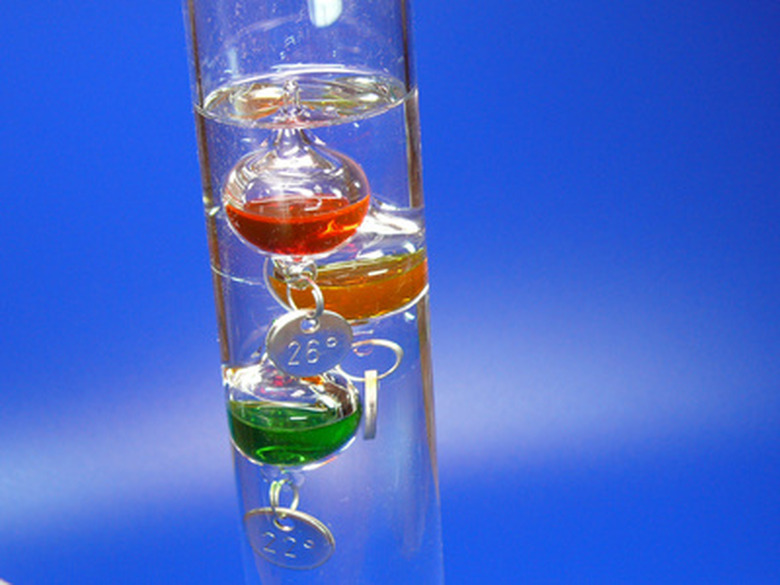What Is The Liquid In Galileo Thermometers?
The liquid in a Galileo thermometer is water. Floating in the water within the tube are glass bubbles also filled with water containing simple food coloring, though sometimes alcohol might be used. The Galileo thermometer is an accurately functioning machine that is more often than not used today as decoration.
History
History
According to Louis A. Bloomfield, the Galileo thermometer functions according to Archimedes' principle of buoyancy, which states that any object in a fluid is buoyed up by a force equal to that of the fluid it displaces (see "Thermometers and Thermostats Home Page", below). As the temperature rises, the density of the water within the thermometer's tube is reduced. This has the effect of rendering the glass bubbles less likely to float.
Mechanics
Mechanics
Each glass bubble is filled with the same amount of water. Attached to each is a metal tag with an engraved number and degree symbol (see "Galileo Thermometer Operation", below). Each metal tag is a different weight, which has the effect of subtly calibrating the bubbles. As the density of the water in the tube expands or contracts, the bubbles float or sink accordingly.
Function
Function
In a Galileo thermometer equipped with five glass bubbles, a range of 20-degrees of temperature is represented. The lightest bubble (the one with the smallest metal tag) denotes the upper range of temperature–80 degrees, for instance. The next lightest bubble indicates 75 degrees, and so on down to the heaviest bubble of 60 degrees.
On a cold day, the clear water in the tube will contract, becoming more dense. As the water contracts, the lighter bubbles float to the top of the tube and the heavier bubbles sink to the bottom. Whichever bubble most closely corresponds to the temperature of the water achieves neutral buoyancy, floating between the lightest and heaviest. This bubble indicates the approximate temperature.
(See "Galileo Thermometer Operation" below for another example.)
Considerations
Considerations
A Galileo thermometer should be positioned away from windows and other sources of heating or cooling. A thermometer in direct sunlight or near a cold window, for example, will be skewed and not accurately portray the temperature. If all the bubbles have sunk to the bottom, it is likely the water in the thermometer is too hot. Likewise, if they have all risen to the top, the water is probably too cold.
Misconceptions
Misconceptions
The liquid in Galileo thermometers need not be alcoholic or mercuric. Simple water is a sufficient and supple conductor of heat. Nor does food-coloring have to be added to the bubbles for the thermometer to work. Rather, the different colors of the floating bubbles make for easier identification and a more pleasant aesthetic.
